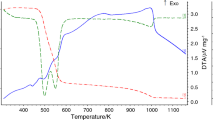Abstract
Substitution of only one bridged hydrogen atom of bis(1,2-cycloheptanedionedioximato)nickel(II) by the diphenylboron group is easily accomplished with formation of1. Both hydroxy groups of bis(dihydroxyboron-diaminoglyoximato)nickel(II) chelate2 can be esterified by phenol or methanol (chelates2 a andb). The bis(diphenylboron) chelate3 a results from the reaction of bis(dihydroxyborondiaminoglyoximato)nickel(II) with diphenylboric anhydride. In the same way the corresponding chelates3 b-f are obtainable from the boron-free nickel chelates. The i.r. and u.v. spectra as well as the diamagnetic character of the compounds described are in agreement with planar structures.
Similar content being viewed by others
Literatur
W. Fedder, H. G. v. Schnering undF. Umland, Z. anorg. allg. Chem.382, 123 (1971).
F. Umland undE. Hohaus mit Beiträgen vonW. Riepe, K. Brodte, C. Schleyerbach, D. Szonn, Forschungsbericht des Landes Nordrhein-Westfalen Nr. 2538/Fachgruppe Chemie. Westdeutscher Verlag.1976. (Gilt als 3. Mitt.)
G. N. Schrauzer, Chem. Ber.95, 1438 (1962).
F. Umland undD. Thierig, Angew. Chem.74, 388 (1962); Angew. Chem., Int. Ed. Engl.1, 333 (1962).
D. Thierig, Dissertation, Technische Hochschule Hannover,1966.
F. Umland undK. Adam, Übungsbeispiele aus der anorganischen Experimentalchemie, S. 313. Stuttgart, S. Hirzel. 1968.
G. C. Pimentel undCh. H. Sederholm, J. Chem. Phys.24, 639 (1956).
E. W. Abel, W. Gerrard undM. F. Lappert, J. Chem. Soc.1957, 3833.
L. J. Bellamy, W. Gerrard, M. F. Lappert undR. L. Williams, J. Chem. Soc.1958, 2412.
Y. Tanabe undS. Sugano J. Phys. Soc. Jpn.9, 766 (1954).
E. Hohaus undW. Riepe, Int. J. Mass Spectrom. Ion Phys.31, 113 (1979).
F. Gallais, J.-P. Laurent undG. Cros, C. R. Acad. Sci.259, 4262 (1964).
E. Fischer, Ber. dtsch. chem. Ges.22, 1930 (1889).
L. Tschugaeff, Z. Anorg. Chem.46, 144 (1905).
L. Tschugaeff undJ. Surenjanz, Ber. dtsch. chem. Ges.40, 181 (1907).
O. Wallach, Liebigs Ann. Chem.437, 148 (1924).
B. A. Soule, J. Amer. Chem. Soc.47, 981 (1925).
Author information
Authors and Affiliations
Additional information
IV. Mitt.:E. Hohaus, Mh. Chem., im Druck.
Rights and permissions
About this article
Cite this article
Fedder, W., Umland, F. & Hohaus, E. Borchelate und Bormetallchelate, V1 . Monatshefte für Chemie 111, 971–980 (1980). https://doi.org/10.1007/BF00899264
Received:
Accepted:
Issue Date:
DOI: https://doi.org/10.1007/BF00899264




